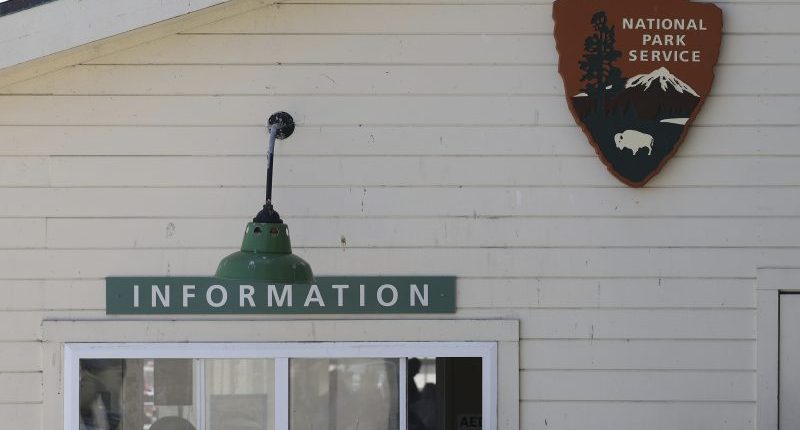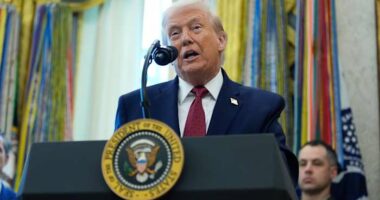Share this @internewscast.com

(NEXSTAR) Just weeks after the Department of the Interior’s budget proposal for fiscal year 2026 suggested a surcharge for some national park visitors, President Donald Trump has signed an executive order calling for just that.
The order, signed Thursday, directs Interior Secretary Doug Burgum to develop a “strategy” to boost revenue and improve recreational experiences at national parks, The Hill reported last week. As part of that, entrance fees and the cost for a recreation pass are intended to rise for “nonresidents.”
International visitors do not currently pay more to visit the national parks than U.S. residents.
The White House said the price hikes will make national parks more affordable for American families.
Here’s what we know about Trump’s order and the Interior Department’s budget proposal.
Interior budget: Surcharge would bring in $90M
The Department of the Interior’s budget proposal for fiscal year 2026 said a surcharge will help bring in more than $90 million, but didn’t outline how.
“There could be a billion-dollar revenue opportunity without discouraging visitors,” Burgum said during a House Committee on Natural Resources oversight hearing in June. He didn’t expand on how the extra fee could bring in more than $90 million, and the Department did not respond to Nexstar’s request for additional information last month.
An analysis by SFGate, using an estimate that 14.6 million international visitors went to U.S. national parks last year, determined that if the parks saw the same number of visitors in 2026, the necessary surcharge to reach the aforementioned budget goal would be about $6 a person.
Fees for out-of-towners aren’t uncommon
“I think we’re way undercharging, as a nation, for international visitors,” Burgum said during June’s oversight hearing. Burgum pointed to other international venues where Americans and other non-resident tourists are charged more than locals, like the Galapagos Islands. There, non-Ecuadorian adults must pay a $200 entrance fee, in cash, to the Galapagos National Park. The entrance fee for children is $100. Meanwhile, Ecuadorian citizens over the age of 12 pay $30 while the fee for younger citizens is $12.
Citizens also have discounted or free admission to popular tourist attractions around the world. College-aged residents of the European Union have free access to several museums within member countries, including the Louvre and The Orsay Museum in Paris. Tourists pay over 20 times more to visit the Taj Mahal than local residents do.
Hawaii will begin charging a “Green Fee” tourist tax next year in order to generate funds for mitigating future environmental challenges the state expects to face. Chicago’s Field Museum offers discounted admission to city residents. Residents of the state of New York are able to pay whatever they prefer to visit The Metropolitan Museum of Art, though they are required to pay at least one penny per ticket. Even Disney World and Disneyland offer deals for those who live near their parks.
What Trump’s order calls for
Regarding international visitors at national parks, Trump’s order calls for increased fees for foreign visitors, as well as a price hike for the America the Beautiful Pass and “any site-specific agency or regional multi-entity passes” that are sold to foreign visitors.
The America the Beautiful Pass is currently available at various price points and provides free entrance into national parks and federal recreational lands. An annual pass, available to “everyone,” is $80. A senior annual pass is $20, while a senior lifetime pass is $80. Others may qualify for a free annual or lifetime pass.
The price hikes, according to Trump’s order, apply only to those parks that charge entrance or recreation pass fees. Currently, only 106 of the 475 sites that are managed by the National Park Service charge an entrance fee.
Neither Trump’s executive order nor the Interior Department’s budget outlined how much entrance and pass fees could rise.
Increased revenue from nonresident visitors would then be used to “improve the infrastructure of, or otherwise enhance enjoyment of or access to, America’s Federal recreational areas.”
Price hikes come with proposed budget reduction
While the foreign visitor fees could bring in more revenue for the parks, the Trump administration has also proposed cutting the National Park Service’s staffing budgets and service operations by 30 percent, The Hill reports.
Meanwhile, the Interior Department’s budget proposal is requesting $2 billion for the national parks, down more than $1 billion from the current budget. It would be the largest cut in NPS history, according to the National Parks Conservation Association (NPCA).
Nonetheless, Trump’s order calls for efforts to increase visitor capacity at America’s national parks, invest in infrastructure at the sites, and improve park access to American families by ensuring they “receive priority access in any permitting or reservation systems.”
The National Park Service had its biggest year of attendance in 2024, with more than two dozen sites seeing record visitation.












